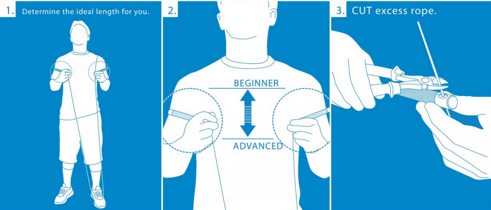Double unders can be a really taxing part of a workout, and a place that slows you down. When we’re first learning we do what we need to do to get the work done, and this isn’t always very efficient. These habits can then stick with us, becoming the real crux in our workout. Double unders can also be a place to make up time and even recover, if you’re efficient. Today I want to chat about two common errors we see in double unders.
Firstly however, what should they look like?
THE GOOD:
https://www.crossfit.com/essentials/the-double-under
It’s more than just passing the rope under your feet twice. It’s also keeping:
1 – Hands slightly in front of hips
2 – Elbows close to the body
3 – Jumping a few inches off the ground
4 – Torso remains upright
5 – Length of the rope
6 – Using your wrists to spin the rope not your whole arm
Then the rest….
THE PIKE JUMP:
This is when someone jumps and keeps their legs locked out and straight, with their feet pointed. A pike jump also forces the feet forward, so that basically the entire body is slightly folding forward in order to rebound, instead of remaining straight up and down. This looks tiring! Sound familiar?

Why might we do this?
It does lift your feet slightly higher off the ground, so may make you feel like you’ll clear the rope FOR sure. It also uses your hip flexors with your calves to get height and it lessens the load on the knees. SO perhaps there is a weakness or injury you’re avoiding. AND now that you do it, YOU CAN’T STOP! AHHHHHHHH!!!!!
THE TUCKING JUMP:
This is when someone either tucks their feet behind them, a sort of donkey kick, or lifts their knees up high in front of them. Doing tuck jumps instead of wee hops is also really tiring.
Again, familiar?

Why might we do this?
Again this lifts your feet higher off the ground, and utilises your knees and hip flexors to gain height. So you feel you’re getting higher and you won’t miss, and you can use alllllll your muscles to do it.
What’s really going on?
What might be the REAL problem? Why do we all want to jump higher?? Let’s go back to our points of performance from the start.
1 and 2 – Elbows tight at your side with the rope slightly in front of you keeps the rope the same length and speed.. When your arms get away from your body or your hands move backward (almost reaching behind you), it takes up a ton of slack in the rope, so it may not even be striking the ground anymore. It’s also going to travel way faster, which isn’t always great if you’re not ready for it. This means YOU HAVE TO JUMP HIGHER or you’ll catch the rope.
3 and 4 -Body upright and small jumps allows us to breathe easier, use less muscle groups to perform the movement, BUT does require you to be able to spin the rope fast enough to get under those feet. A good way around a rope that’s too slow is to jump higher.
5 – If your rope is too long or short, it will either spin too fast for your jump, or spin too slow for your jump. Either way I’m going to want to jump higher now.
6- Swinging your arms as opposed to using your wrists to turn the rope, again will slow the rope down. This may make you want to jump higher to clear the rope
How do we fix it?

1 – Let’s get the rope sorted:
Cut to length – Note it’s the base of the handle at the armpits for beginners, not the top.
2- Practice your jumping without your rope
Small pogo stick jumps, feet under your body, soft landing, push with your toes, not pulling with your hips.
Add in some hand movement with the jump, without the rope – https://www.youtube.com/watch?v=AQANZzMOdDo – This is an awesome way to get rhythm
Practice jumping in front of a wall – this will stop your pikes in a hurry!
3- Practice your jumps with a rope in one hand, spinning it while you jump. This will keep you honest with your arm position and rope speed, and let you practice rhythm.
4 – single skips with a nice upright jump and good elbow and hand position. Your double under is only a slightly bigger jump, with faster wrists.
Double unders are more technical than we think, and it really pays off to be efficient. Practice little and often (don’t want to jack up those calves). Don’t just get the work done, work on your form, it’ll pay off.
Gina Di Rienzo
CrossFit Central Wellington Senior Coach





